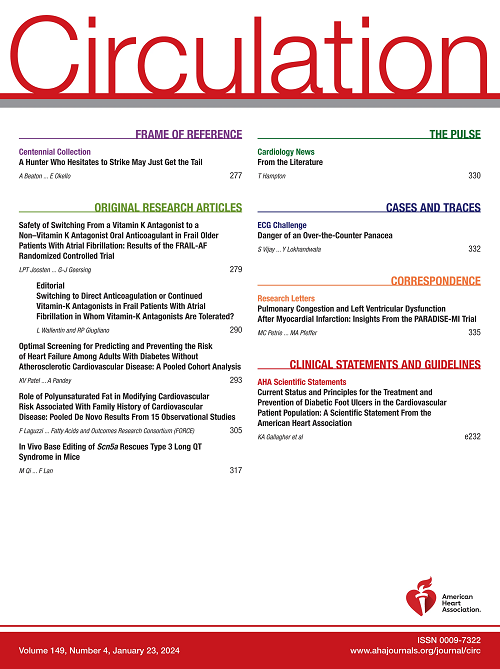A2AR-D2R二聚化和d2r偏倚信号在pde10a介导的心肌肥厚中的作用
IF 38.6
1区 医学
Q1 CARDIAC & CARDIOVASCULAR SYSTEMS
引用次数: 0
摘要
病理性心肌细胞(CM)肥大是扩张型心肌病和心力衰竭的标志,由机械或神经体液应激驱动。尽管我们之前已经证明PDE10A(磷酸二酯酶10A)是病理性心脏重构和功能障碍的关键因素和潜在治疗靶点,但其潜在机制尚不清楚。在这里,我们研究了PDE10A在CM肥大中调节的环核苷酸的特定信号通路和来源。方法采用血管紧张素II诱导离体成年小鼠CMs的scm肥大,通过细胞表面积和蛋白合成来评价其肥大程度。PDE10A失活是通过PDE10A敲除或TP-10抑制实现的。利用多巴胺受体D2 (D2R)和腺苷受体2A (A2AR)的多种药理激动剂/拮抗剂、基因突变体和敲除模型,在体外和体内研究A2AR-D2R异源二聚体及其下游信号在CM肥大中的作用。利用病毒载体操纵针对关键信号分子的蛋白或shRNA表达。结果我们证明PDE10A失活的抗肥厚作用特异性依赖于cAMP/PKA(蛋白激酶A)信号。重要的是,我们在CMs中发现了A2AR-D2R异源二聚体及其与PDE10A的关联。A2AR-D2R异源二聚体介导β - arr2 (β -抑制蛋白2)偏倚的D2R信号,激活D2R偏倚的信号可拮抗心脏肥厚和功能障碍。PDE10A缺乏或抑制会增强A2AR-D2R异源二聚化,通过增加A2AR/cAMP/ pka介导的D2R磷酸化,促进βarr2偏倚的D2R信号和下游PP2A(蛋白磷酸酶2A)-B56δ活化。PDE10A失活抑制应激信号诱导的依赖于PP2A的HDAC5(组蛋白去乙酰化酶5)核输出和磷酸化。动物模型的遗传和药理学方法证实了A2AR-D2R异源二聚化、D2R磷酸化和D2R偏倚信号在体内的关键作用。此外,将PDE10A抑制与A2AR或d2r偏向激动剂联合使用可产生协同抗肥厚作用,突出了它们的新型治疗潜力。结论A2AR-D2R二聚化和βarr2偏倚的D2R信号是对抗病理性CM肥大和心功能障碍的新的关键机制。PDE10A作为该信号轴的关键负调节因子。靶向PDE10A, A2AR-D2R/βarr2信号,或两者兼而有之,为对抗病理性心脏重塑和心功能障碍提供了潜在的新治疗策略。本文章由计算机程序翻译,如有差异,请以英文原文为准。
Role of A2AR-D2R Dimerization and D2R-Biased Signaling in PDE10A-Mediated Cardiac Hypertrophy.
BACKGROUND
Pathological cardiomyocyte (CM) hypertrophy is a hallmark of dilated cardiomyopathy and heart failure, driven by mechanical or neurohumoral stress. Although we previously demonstrated PDE10A (phosphodiesterase 10A) as a critical contributor and potential therapeutic target in pathological cardiac remodeling and dysfunction, the underlying mechanisms remain unclear. Here, we investigated the specific signaling pathways and sources of cyclic nucleotides modulated by PDE10A in CM hypertrophy.
METHODS
CM hypertrophy was induced by angiotensin II in isolated adult mouse CMs, with hypertrophy assessed by cell surface area and protein synthesis. PDE10A inactivation was achieved through PDE10A knockout or inhibition with TP-10. Various pharmacological agonists/antagonists, genetic mutants, and knockout models of D2R (dopamine receptor D2) and A2AR (adenosine receptor 2A) were used to study the role of A2AR-D2R heterodimer and downstream signaling in CM hypertrophy in vitro and in vivo. Viral vectors were used to manipulate protein or shRNA expression targeting key signaling molecules.
RESULTS
We demonstrated that the antihypertrophic effect of PDE10A inactivation is specifically dependent on cAMP/PKA (protein kinase A) signaling. Importantly, we discovered an A2AR-D2R heterodimer and its association with PDE10A in CMs. The A2AR-D2R heterodimer mediates the βarr2 (beta-arrestin 2)-biased D2R signaling, and activating D2R-biased signaling antagonizes cardiac hypertrophy and dysfunction. PDE10A deficiency or inhibition enhanced A2AR-D2R heterodimerization, promoting βarr2-biased D2R signaling and downstream PP2A (protein phosphatase 2A)-B56δ activation through increased A2AR/cAMP/PKA-mediated D2R phosphorylation. PDE10A inactivation inhibits stress signal-induced HDAC5 (histone deacetylase 5) nuclear export and phosphorylation, which are dependent on PP2A. Genetic and pharmacological approaches in animal models confirmed the critical roles of A2AR-D2R heterodimerization, D2R phosphorylation, and biased D2R signaling in vivo. Furthermore, combining PDE10A inhibition with A2AR or D2R-biased agonism produced synergistic antihypertrophic effects, highlighting their novel therapeutic potential.
CONCLUSIONS
Our findings reveal A2AR-D2R dimerization and βarr2-biased D2R signaling as novel and critical mechanisms for counteracting pathological CM hypertrophy and cardiac dysfunction. PDE10A acts as a pivotal negative regulator of this signaling axis. Targeting PDE10A, A2AR-D2R/βarr2 signaling, or both offers potentially novel therapeutic strategies for combating pathological cardiac remodeling and cardiac dysfunction.
求助全文
通过发布文献求助,成功后即可免费获取论文全文。
去求助
来源期刊

Circulation
医学-外周血管病
CiteScore
45.70
自引率
2.10%
发文量
1473
审稿时长
2 months
期刊介绍:
Circulation is a platform that publishes a diverse range of content related to cardiovascular health and disease. This includes original research manuscripts, review articles, and other contributions spanning observational studies, clinical trials, epidemiology, health services, outcomes studies, and advancements in basic and translational research. The journal serves as a vital resource for professionals and researchers in the field of cardiovascular health, providing a comprehensive platform for disseminating knowledge and fostering advancements in the understanding and management of cardiovascular issues.
 求助内容:
求助内容: 应助结果提醒方式:
应助结果提醒方式:


